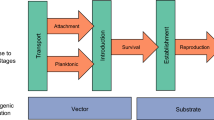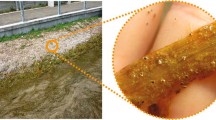Summary
Since the opening of the Suez Canal, more than 120 Red Sea species colonized the eastern Mediterranean, whereas less than 10 Mediterranean species colonized the Red Sea. For most of the species involved in this colonization, the mode of dispersal from the source to the colonized area is through free-drifting propagules. In order to examine whether the current regime of the Suez Canal may be involved in this assymetry in colonization, a mathematical hydraulic model that forecasts the direction and velocity of water currents through the year, along the length of the Canal, was utilized. The movements of free-floating propagules that occur at either entrance of the Canal, was simulated on a computer, and it was found that the completion of a Mediterranean-bound passage of Red Sea propagules is far faster and much more likely than a completion of a Red Sea-bound passage of Mediterranean propagules.
Similar content being viewed by others
References
Aron WI, Smith SH (1971) Ship Canals and Aquatic Ecosystems. Science 174:13–20
Ben-Tuvia A (1973) Man Made changes in the eastern Mediterranean and their effect on the fishery resources. Marine Biol 19:197–203
Ben-Tuvia A (1978) Immigration of fishes through the Suez Canal. Fisheries Bull 76:249–255
Fox MH (1926) Cambridge Expedition to the Suez Canal. 1924, General part. Trans Zool Soc Lond 22: Part 1. No 1
Kimor B (1972) Contributions to the knowledge of the Suez Canal migration. Isr J Zool 21:391–403
Lipkin Y (1972) Marine algal and sea-grass flora of the Suez Canal. Isr J Zool 21:405–446
Morcos SA (1959) Ph D Thesis Univ Kiel
Morcos SA (1960) The tidal currents in the southern part of the Suez Canal. Inst Assoc Scien Hyd Int Ass Phys Ocean, IUGG Helsinki, 51:307–316
Por FD (1978) Lessepsian Migration — The influx of Red-Sea Biota into the Mediterranean by way of the Suez Canal. Ecological studies, Vol 23, Berlin-Heidelberg-New York, Springer
Safriel U, Lipkin Y (1975) Patterns of colonizations of the eastern Mediterranean intertidal zone by Red-Sea immigrants. J Ecol 63:61–63
Safriel U, Ritte U (1980) Criteria for the identification of potential colonizers. Biol J Linn Soc Lond 13:287–297
Shemobin OH (1972) Wind-generated current and phase speed of wind waves. J Phys Oceanogr 2:411–419
Steinitz W (1929) Die Wanderung indopazifischer Arten ins Mittelmeer seit Beginn der Quatarperiode. Int Rev Hydrobiol 22:1–90
Stiassnie M A mathematical hydraulic model for the current regime of the Suez Canal. Mimeographed handout and a computer printout. Technion Inst. of Technology, Haifa, Israel
Thorson G (1950) Reproductive and larval ecology of marine bottom invertebrates. Biol Rev 25:1–45
Thorson G (1971) Animal Migration through the Suez Canal in the past, recent years and in the future. Vie et Milieu 2:841–846
Uziel J (1968) Sea level at Ashdod and Elat: differences between prediction and observations. Isr J Earth-Sciences 17:137–151
Author information
Authors and Affiliations
Additional information
Paper No. 7 in the series “Colonization of the Eastern Mediterranean by Red Sea species immigrating through the Suez Canal”
Rights and permissions
About this article
Cite this article
Agur, Z., Safriel, U.N. Why is the mediterranean more readily colonized than the Red Sea, by organisms using the Suez Canal as a passageway?. Oecologia 49, 359–361 (1981). https://doi.org/10.1007/BF00347598
Issue Date:
DOI: https://doi.org/10.1007/BF00347598




